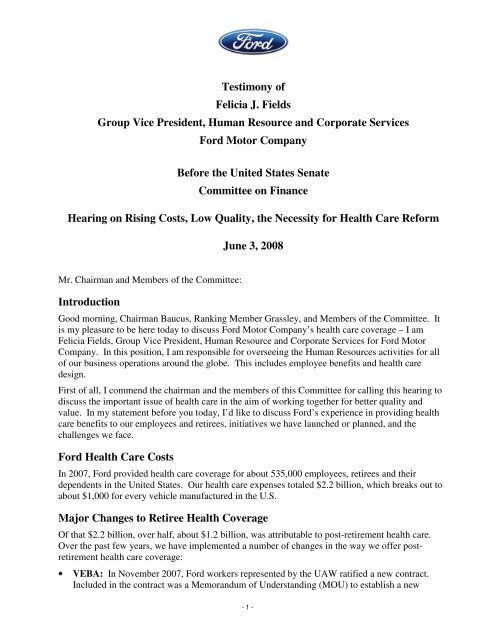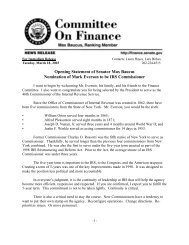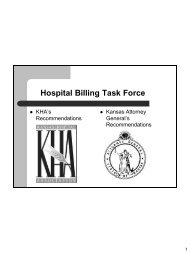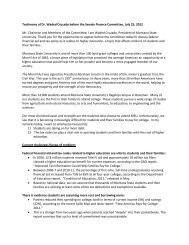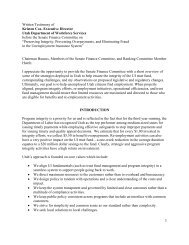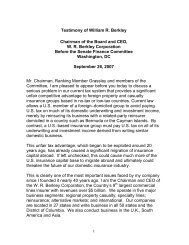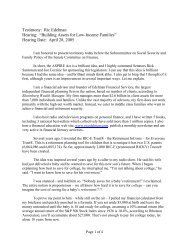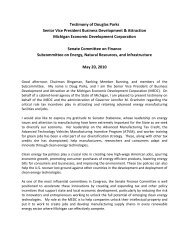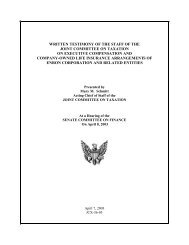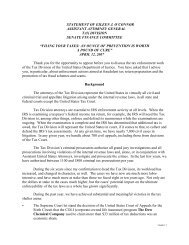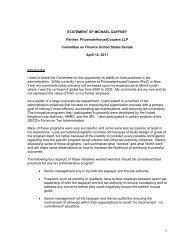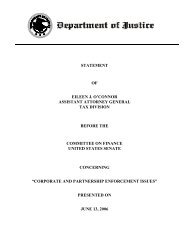Testimony of Felicia J. Fields Group Vice President, Human ...
Testimony of Felicia J. Fields Group Vice President, Human ...
Testimony of Felicia J. Fields Group Vice President, Human ...
Create successful ePaper yourself
Turn your PDF publications into a flip-book with our unique Google optimized e-Paper software.
<strong>Testimony</strong> <strong>of</strong><br />
<strong>Felicia</strong> J. <strong>Fields</strong><br />
<strong>Group</strong> <strong>Vice</strong> <strong>President</strong>, <strong>Human</strong> Resource and Corporate Services<br />
Ford Motor Company<br />
Before the United States Senate<br />
Committee on Finance<br />
Hearing on Rising Costs, Low Quality, the Necessity for Health Care Reform<br />
Mr. Chairman and Members <strong>of</strong> the Committee:<br />
Introduction<br />
June 3, 2008<br />
Good morning, Chairman Baucus, Ranking Member Grassley, and Members <strong>of</strong> the Committee. It<br />
is my pleasure to be here today to discuss Ford Motor Company’s health care coverage – I am<br />
<strong>Felicia</strong> <strong>Fields</strong>, <strong>Group</strong> <strong>Vice</strong> <strong>President</strong>, <strong>Human</strong> Resource and Corporate Services for Ford Motor<br />
Company. In this position, I am responsible for overseeing the <strong>Human</strong> Resources activities for all<br />
<strong>of</strong> our business operations around the globe. This includes employee benefits and health care<br />
design.<br />
First <strong>of</strong> all, I commend the chairman and the members <strong>of</strong> this Committee for calling this hearing to<br />
discuss the important issue <strong>of</strong> health care in the aim <strong>of</strong> working together for better quality and<br />
value. In my statement before you today, I’d like to discuss Ford’s experience in providing health<br />
care benefits to our employees and retirees, initiatives we have launched or planned, and the<br />
challenges we face.<br />
Ford Health Care Costs<br />
In 2007, Ford provided health care coverage for about 535,000 employees, retirees and their<br />
dependents in the United States. Our health care expenses totaled $2.2 billion, which breaks out to<br />
about $1,000 for every vehicle manufactured in the U.S.<br />
Major Changes to Retiree Health Coverage<br />
Of that $2.2 billion, over half, about $1.2 billion, was attributable to post-retirement health care.<br />
Over the past few years, we have implemented a number <strong>of</strong> changes in the way we <strong>of</strong>fer postretirement<br />
health care coverage:<br />
• VEBA: In November 2007, Ford workers represented by the UAW ratified a new contract.<br />
Included in the contract was a Memorandum <strong>of</strong> Understanding (MOU) to establish a new<br />
- 1 -
independent Voluntary Employee Benefit Association trust (VEBA). Starting January 1, 2010,<br />
(pending federal district court approval and SEC pre-clearance <strong>of</strong> the accounting treatment <strong>of</strong><br />
the VEBA and the hourly retiree health care obligation), the trust will administer post-retirement<br />
health care benefits to all former UAW-represented employees and current employees who were<br />
active as <strong>of</strong> the effective date <strong>of</strong> the new contract.<br />
Upon implementation <strong>of</strong> the final settlement agreement, Ford will contribute $13.2 billion in<br />
assets to the VEBA. Its earnings will remain exclusively within the VEBA. This new, mutuallyagreed<br />
to arrangement will permanently shift complete responsibility for providing retiree health<br />
care benefits for current and former UAW-represented employees (measured at $20.2 billion on<br />
our December 31, 2007 balance sheet) from the Company to the VEBA.<br />
• Coverage for Salaried Retirees: We have also taken steps to address costs <strong>of</strong> salaried retiree<br />
health care benefits.<br />
o For retirees under 65, we capped our contributions at 2006 levels.<br />
o Effective January 1, 2008, for retirees aged 65 and over or Medicare eligible due to age or<br />
disability, we credit health reimbursement arrangements (or HRAs) in the amount <strong>of</strong> $1,800<br />
per member per year. In order to ease retirees' transition into the competitive individual<br />
Medicare market, Ford provides retirees with an electronic enrollment and advocacy service<br />
that assists them in finding the coverage that best meets their needs and preferences, thus<br />
easing the paperwork burden. While planning this transition assistance program, we have<br />
received invaluable advice from State Health Insurance Program (SHIP) consumer<br />
assistance groups such as the Michigan Medicare/Medicaid Assistance Program (MMAP).<br />
o For new hires (those hired or rehired on or after June 1, 2001), in addition to providing<br />
coverage while they are an active employee, we credit HRAs with up to $800/year for each<br />
year they work at Ford. Upon meeting the age and years-worked criteria for vesting, when<br />
these employees leave the Company, they will be able to draw upon their HRA for<br />
reimbursement <strong>of</strong> eligible medical expenses.<br />
Continuing Challenges<br />
While these measures are necessary to ensure our ability to continue <strong>of</strong>fering health care benefits to<br />
our employees and retirees without compromising financial viability <strong>of</strong> the company, we are still<br />
concerned with the rate <strong>of</strong> U.S. health care cost increases which are projected to exceed overall<br />
inflation rate. The Centers for Medicare and Medicaid Services expects national health care<br />
spending to double between 2007 and 2017, increasing from $2.25 trillion in 2007 to $4.28 trillion<br />
by 2017.<br />
Although there is no shortage <strong>of</strong> proposals on how to manage cost increases, a majority <strong>of</strong> the<br />
effective actions should be implemented only after careful deliberation and consensus development<br />
by all key stakeholders with strong leadership at the federal level.<br />
To address the challenges at hand, I would like to share with you some <strong>of</strong> the steps we have taken at<br />
Ford, some independently, and some in collaboration with other stakeholders. I will then share<br />
some specific suggestions on areas where federal leadership would be most helpful.<br />
Company Initiatives<br />
Creating a Culture <strong>of</strong> Wellness Through Education and Providing Necessary Tools<br />
Among the key drivers <strong>of</strong> health care costs are aging and declining health status. Therefore, we are<br />
creating a culture <strong>of</strong> health and wellness for our employees and their families as a central<br />
component <strong>of</strong> our health care strategy. As the first step, we started providing resources and tools to<br />
- 2 -
improve their health status and help them make sound choices about health care services and<br />
coverage and help them understand the benefits <strong>of</strong> being a better health care consumer. We aim to<br />
work with our vendor partners on the creation <strong>of</strong> benefit options that engage people in improving<br />
their health status and making wise choices. We also aim to ensure that employees have the<br />
information they need to make the selections that are best for their individual situations. We<br />
concentrate on three main areas: 1) engaging the consumer in their health, 2) providing userfriendly<br />
tools to encourage wellness, and 3) creating partnerships to strengthen the health care<br />
delivery system and improve technology transfer. Our efforts include:<br />
• An internal wellness campaign to encourage and motivate employees to take control <strong>of</strong> their<br />
health by:<br />
o Providing the skills that will help them understand their risks, and improve their health<br />
habits; and<br />
o Encouraging them to be better health care consumers by using health care quality<br />
information.<br />
Currently, we are redesigning this campaign to substantially increase the outreach and expand<br />
the scope. Employees are encouraged to complete health risk assessments, prepare advance<br />
directives, and engage in a personal health plan with their primary care physician. We are also<br />
working to provide a more supportive at-work environment (e.g., more nutritious cafeteria<br />
selections, a hand-washing campaign to decrease cold and flu outbreaks, engaging Wellness<br />
Ambassadors in plants, etc.).<br />
• An employee health improvement program and website, called "Healthy Highway," to prevent<br />
and manage illness, which includes:<br />
o Disease management,<br />
o Individualized health coaching programs,<br />
o Health appraisals, and<br />
o 24-hour phone access to nurse and on-site screening services.<br />
• Online benefit comparison guide with educational information, which includes quality ratings <strong>of</strong><br />
health plans, prescription drug information and links to important health care information<br />
websites.<br />
• Managing prescription drug costs: prescription drug coverage <strong>of</strong> our self-insured health plans<br />
requires substitutions whenever chemically identical generic alternatives are available. Such<br />
requirement benefits both employees and the company since:<br />
o Employee co-pays are at least 50% lower for generic drugs, and<br />
o On average, cost per prescription for generic drugs is about one-fifth <strong>of</strong> cost per prescription<br />
for brand-name drugs.<br />
• Community Initiative projects in Kansas City and Louisville with our UAW partners to improve<br />
the health <strong>of</strong> not just Ford workers but all members <strong>of</strong> the community by working to spread best<br />
practice guidelines, and to create partnerships to improve the quality and value <strong>of</strong> care.<br />
Improving Infrastructure<br />
We recognized one <strong>of</strong> the important tools our employees need to improve their health status and<br />
become a more informed health care consumer is the infrastructure to facilitate information<br />
gathering. We determined that the most effective approach for building such an infrastructure is<br />
through a regional collaboration with key stakeholders:<br />
• In 2004, Ford -- jointly with GM, Chrysler, Blue Cross Blue Shield <strong>of</strong> Michigan and Medco<br />
Health Solution -- created the Southeast Michigan e-Prescribing Initiative (SEMI). The SEMI<br />
- 3 -
initiative, which is one <strong>of</strong> the largest employer-driven e-Prescribing initiatives in the country, is<br />
focused on promoting the adoption and use <strong>of</strong> e-Prescribing, and validating the impact <strong>of</strong> e-<br />
Prescribing technology on improving patient safety and reducing prescription drug costs.<br />
Through this initiative, we are promoting e-Prescribing infrastructure service and <strong>of</strong>fering a<br />
nominal financial incentive to any physician practicing in Southeast Michigan who signs up.<br />
To date, 2,897 physicians have enrolled in SEMI, and they have written over 8 million<br />
electronic prescriptions. SEMI physicians changed prescriptions 39% <strong>of</strong> the time to less<br />
expensive generics, when a formulary alert was presented at the point <strong>of</strong> care. More than 1<br />
million alerts were sent on moderate to severe drug-to-drug risks, resulting in 41% <strong>of</strong> those<br />
prescriptions being changed or canceled by the physician. This initiative has helped move<br />
Michigan into the top 5 <strong>of</strong> e-Prescribing states.<br />
A recent survey <strong>of</strong> physicians in the program revealed that improved patient safety and quality<br />
<strong>of</strong> care topped the list <strong>of</strong> key benefits <strong>of</strong> the technology:<br />
o 75 percent <strong>of</strong> prescribers believe strongly that e-Prescribing improves safety for their<br />
patients, and nearly 70 percent say it improves the quality <strong>of</strong> care.<br />
o More than 80 percent <strong>of</strong> all prescriptions written by those surveyed are currently written<br />
electronically; four <strong>of</strong> 10 practices now only write e-Prescriptions.<br />
o More than 70 percent saw a reduction in communications with pharmacies over prescription<br />
questions.<br />
o More than half strongly agree that e-Prescribing saves clinicians' time and increases<br />
productivity.<br />
These survey results clearly demonstrate e-Prescribing decreases errors, increases quality, and<br />
creates value.<br />
• In 2006, we led the formation <strong>of</strong> Southeast Michigan Health Information Exchange<br />
(SEMHIE), also with GM and Chrysler to create the infrastructure needed for transmission <strong>of</strong><br />
health care information among the health care providers and patients throughout the region.<br />
This initiative has since expanded to 46 participants, which include most major hospitals,<br />
insurance plans, several physician organizations and other key stakeholders in the region.<br />
Last year, the initiative received $1.4 million planning grant from the State <strong>of</strong> Michigan to assist<br />
formation <strong>of</strong> a formal entity and governance structure, drafting and approval <strong>of</strong> a business plan,<br />
and all other activities needed prior to implementation <strong>of</strong> the regional health information<br />
exchange. The effort is progressing to complete this planning phase by this fall but we face a<br />
significant challenge in raising start-up funding.<br />
Our leadership in this area is well recognized throughout the State <strong>of</strong> Michigan, as evidenced by<br />
Governor Granholm's appointment <strong>of</strong> a Ford Manager to represent employers at the thirteenmember<br />
Michigan Health Information Technology Commission. This Commission is charged<br />
with formulating strategies to promote adoption <strong>of</strong> information technology by health care<br />
system in Michigan.<br />
Involving Physicians<br />
We also recognized that in many cases, our employees with chronic diseases need greater<br />
involvement by their primary care physicians to plan and implement programs for improving their<br />
health status. However, physicians are <strong>of</strong>ten overwhelmed by simply providing regular care.<br />
Therefore, we have agreed to take a leadership role in Michigan's participation in the Improving<br />
Performance in Practice (IPIP) Initiative, sponsored by the Michigan Primary Care Consortium<br />
through a grant from the American Board <strong>of</strong> Medical Specialties and the Robert Wood Johnson<br />
Foundation. The steering committee for the Michigan initiative, which is composed <strong>of</strong> all <strong>of</strong> the<br />
- 4 -
allopathic and osteopathic primary care organizations in the state, is chaired by Ford Motor<br />
Company's Medical Director.<br />
The initiative's key goals are:<br />
• Provide primary care physicians the necessary tools to ensure patients receive recommended<br />
chronic disease and preventive services (such as peer-reviewed practice guidelines and<br />
reportable metrics).<br />
• Provide physicians tools to improve their practice's efficiency. This way they can allocate more<br />
time for more serious health conditions. This involves using quality improvement health care<br />
pr<strong>of</strong>essionals trained to review physician <strong>of</strong>fices and recommend process improvement.<br />
So far, we have accomplished:<br />
• Adoption <strong>of</strong> one set <strong>of</strong> state guidelines for diabetes and asthma management,<br />
• Development <strong>of</strong> one set <strong>of</strong> metrics for determining adherence to the guidelines, and<br />
• Receipt <strong>of</strong> seed funds from a variety <strong>of</strong> sources and identifying automotive industry quality<br />
coaches for training. For this purpose, Ford is devoting a "Six Sigma master blackbelt engineer"<br />
for the next eighteen months.<br />
We are scheduled to place the quality coaches in ten primary care <strong>of</strong>fices in late June, followed by<br />
twenty more <strong>of</strong>fices in September. One hundred more practices will be added to the initiative next<br />
year.<br />
Communicating Expectation <strong>of</strong> Accountability by Insurance Plans and Providers<br />
Finally, we continuously communicate our expectations to our major health care suppliers, through<br />
conferences and individual meetings. We meet with the senior leadership <strong>of</strong> virtually all <strong>of</strong> Ford’s<br />
health plans and major providers (hospitals and physicians) to convey the importance <strong>of</strong> improving<br />
efficiency and safety.<br />
Importantly, we have made substantial progress in incorporating the Four Cornerstone tenets<br />
outlined by <strong>President</strong> Bush and HHS Secretary Leavitt in our contracts with health plans and we<br />
will hold them accountable for performance and outcomes. These fundamental principles are key to<br />
quality and value and we commend the ongoing effort by the Department <strong>of</strong> Health and <strong>Human</strong><br />
Services in establishing the framework and championing a true multi-stakeholder initiative.<br />
Policy Recommendations<br />
I hope this helps you better understand the challenges that employers face providing health care<br />
coverage and the roles that employers can play in addressing some <strong>of</strong> the challenges. As our overall<br />
business environment continues to be extremely challenging due to strong global competition, new<br />
fuel economy standards, and recent credit market constrictions, it is critical for us to continue<br />
seeking every innovative approach to manage health care costs in order to ensure our business<br />
remains viable.<br />
Finally, I’d like to leave you with some policy suggestions on how Congress and the federal<br />
government could assist employers to continue <strong>of</strong>fering health care benefits.<br />
• Focus on Affordability<br />
Much recent discussion on health care reform has justifiably centered on uninsured population.<br />
However, we believe too much <strong>of</strong> that discussion focuses on mechanisms to expand coverage<br />
such as financing, modifying insurance markets, and mandates.<br />
- 5 -
We suggest a better approach is to improve health care coverage affordability by evaluating the<br />
key cost drivers <strong>of</strong> health care and how to address them. Simply subsidizing excessive health<br />
care spending does not <strong>of</strong>fer a long-term solution to our health care problems. In fact, it may<br />
well exacerbate them. Instead, by first making health care coverage more affordable, the entire<br />
health care population -- uninsured and insured alike -- would benefit both immediately and<br />
over the long-term.<br />
• Address Prescription Drug Costs<br />
Over the last several years, generic substitution has allowed us to control the rate <strong>of</strong> increase <strong>of</strong><br />
our prescription drug costs. However, one element <strong>of</strong> our prescription drug costs that continues<br />
to increase rapidly is biopharmaceuticals or biologics. For those suffering life-threatening and<br />
chronic illnesses, biologics provide great hope, but their price – <strong>of</strong>ten well over $100,000 per<br />
patient per year – can put them out <strong>of</strong> reach.<br />
Since there is currently no regulatory pathway to approve generic versions <strong>of</strong> these biologics,<br />
prices remain prohibitively expensive in perpetuity. While we support maintaining drug<br />
companies' ability to pr<strong>of</strong>it from new life-saving products, monopoly pricing has been balanced<br />
in other drugs. Therefore, we urge the Congress to enact a legislation to give the FDA authority<br />
to approve safe and effective biogenerics that balance pr<strong>of</strong>it with patient safety.<br />
• Remove Legislative and Regulatory Barriers on Wellness Programs<br />
Incentive-based wellness programs are currently limited to 20% <strong>of</strong> the cost <strong>of</strong> coverage.<br />
Raising this percentage to a higher level would allow greater incentives for people taking an<br />
interest in wellness behaviors. This is good for them, good for us, and good for the country.<br />
Additionally, the current wellness regulations require that employers treat equally those who<br />
succeed, and those who try but fail to change a voluntary behavior (e.g., losing weight, quitting<br />
smoking, etc.). To prevent gaming <strong>of</strong> the system, we suggest modifying regulations regarding<br />
voluntary behaviors to enable wellness programs to <strong>of</strong>fer differential rewards based on whether<br />
an outcome is achieved. This would allow employers to reward those who actually do the hard<br />
work to improve their health status and adopt better health practices. It is important to note that<br />
we would advocate this approach only for voluntary behaviors and habits – things that we as<br />
individuals can accomplish with dedication.<br />
• Enable Breakthroughs that Improve Patient Care<br />
Similarly, we recommend a strong leadership at the federal level for establishing one set <strong>of</strong><br />
standards for health care quality and one set <strong>of</strong> best practice guidelines for improving the<br />
population's health status. The federal government, including the Center for Medicare and<br />
Medicaid Services, can provide a central leadership role by adopting constructive policies,<br />
which can then – and certainly will – be replicated in the private sector. Areas where the federal<br />
government could play this pivotal role include:<br />
o Adoption <strong>of</strong> a comprehensive set <strong>of</strong> standards for meaningful comparisons <strong>of</strong> health plan,<br />
hospital, and physician cost, quality and satisfaction performance that are publicly available.<br />
o Creation <strong>of</strong> a knowledge management and data base system on outcomes and effectiveness<br />
that can better guide the extent that proposed new technology and drugs improve treatment<br />
outcome. The Agency for Health Quality Research is charged with this critical work but<br />
much more needs to be done and additional resources need to be provided.<br />
o Addressing the issue <strong>of</strong> end <strong>of</strong> life care, patient preferences, and creating more humane<br />
experiences in the last stages <strong>of</strong> life. Studies estimate 30% <strong>of</strong> Medicare spending goes for<br />
- 6 -
care <strong>of</strong> patients in their last year <strong>of</strong> life. Often, patients' preferences are needlessly<br />
disregarded.<br />
o Creation <strong>of</strong> a mandatory anonymous error reporting system to allow us to learn from our<br />
mistakes on a national basis. This approach has produced dramatic improvements in other<br />
areas and <strong>of</strong>fers great promise for medicine as well.<br />
• Provide Funding to Assist Start up <strong>of</strong> Regional Health Information Exchange (HIE)<br />
Initiatives<br />
Many benefits stem from adoption <strong>of</strong> health information technology (HIT):<br />
o Improved care delivery as treating physicians have access to a patient's complete medical<br />
information, not just information stored in their <strong>of</strong>fices, and<br />
o Elimination <strong>of</strong> duplicative tests and procedures.<br />
These are only achievable if there is an infrastructure allowing electronic storage and exchange<br />
<strong>of</strong> such information.<br />
This is why we are leading the initiative in Southeast Michigan to create such an infrastructure.<br />
But as I stated earlier, we face a significant challenge in raising start-up funding. We suggest<br />
federal assistance for such start-up funding. Funding through state grants would enable each<br />
state to evaluate the viability <strong>of</strong> each regional HIE initiatives before <strong>of</strong>fering financial support.<br />
It would be each regional HIE initiative's responsibility to formulate a sustainable plan for ongoing<br />
operation so our suggestion on support is strictly for the start-up funding.<br />
• Preserve ERISA and Promote Uniformity<br />
As an employer that <strong>of</strong>fers health care benefits in all fifty states, it is critical that we have the<br />
ability to <strong>of</strong>fer and maintain uniform benefits throughout the United States. This flexibility to<br />
determine how to best meet the needs <strong>of</strong> our employees and retirees is crucial to our employees<br />
and to Ford. Congress understood this critical need when it enacted ERISA, which provides<br />
multi-state employers with a consistent approach to administration and design <strong>of</strong> nationwide<br />
health benefits. Therefore, this federal framework must be not only preserved, but strengthened<br />
where appropriate.<br />
Closing<br />
I’d like to thank you once again for the invitation to share our experiences with you. I commend<br />
you for examining this very critical issue. I am grateful for your interest in Ford's experience in<br />
health care benefit provision. Quality and value are integral to our core business and equally vital<br />
to health care. We <strong>of</strong>fer our firm commitment <strong>of</strong> partnership to work with you on constructive<br />
solutions.<br />
This completes my statement, Mr. Chairman and I’d be happy to respond to your questions.<br />
- 7 -


